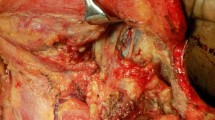Abstract
Purpose
The major complication of neck dissection and surgery at the posterior triangle of the neck is the shoulder syndrome, which results from spinal accessory nerve injury. Erb’s point (the great auricular nerve) and the point where the spinal accessory nerve enters the trapezius muscle are used to identify the spinal accessory nerve in the posterior nerve triangle.
Materials and methods
Measurements were made during unilateral neck dissections in 30 patients to identify the relationship between the spinal accessory nerve and great auricular nerve and the distance between the entrance of the accessory nerve in the trapezious and clavicle.
Results
The distance between the spinal accessory nerve and Erb’s point was ranging from 0 to 3.8 cm (mean 1.53 cm). The distance between the spinal accessory nerve entering the trapezious muscle and the clavicle was between 2.5 and 7.3 cm (mean 4.8 cm).
Conclusions
Since the great auricular nerve (Erb’s point) represents a constantly identifiable landmark, it allows simple and reliable identification of the course of the spinal accessory nerve. Also useful, but of secondary importance in our opinion, is identifying the nerve at the point where it enters the trapezius muscle.



Similar content being viewed by others
References
Kaji T, Aizawa S, Uemura M, Yasuki K (2001) Establishment of the left right asymmetric innervation of the Lancelot oral region. J Comp Neurol 435:394–405
Younossi-Hartenstein A, Jones M, Hartenstein V (2001) Embryonic development of the nervous system of the temnocephalid flatworm Craspedella pedum. J Comp Neurol 435:259–262
Symes A, Ellis H (2005) Variations in the surface anatomy of the spinal accessory nerve in the posterior triangle. Surg Radiol Anat 27:404–408
Caliot PH, Cabaine P, Bousquet V, Midy D (1989) A contribution to the study of the accessory nerve: surgical implications. Surg Radiol Anat 11:11–15
Krause HR, Bremerich A, Hermann M (1991) The innervation of the trapezius muscle in connection with radical neck dissection—an anatomical study. J Craniomaxillofac Surg 19:87–89
Soo KC, Guiloff RJ, Oh A, Della Rovere GQ, Westbury G (1986) Innervation of the trapezius muscle: a study in patients undergoing neck dissection. Head Neck Surg 12:488–495
Aramrattana A, Sittitrai P, Harnsiriwattanagit K (2005) Surgical anatomy of the spinal accessory nerve in the posterior triangle of the neck. Asian J Surg 28:171–173
Hone SW, Ridha H, Rowley H, Timon CI (2001) Surgical landmarks of the spinal accessory nerve in modified radical neck dissection. Clin Otolaryngol 26:16–18
Leung MKS, Dieu T, Cleland H (2004) Surgical approach to the accessory nerve in the posterior triangle of the neck. Plast Rec Surg 6:2067–2070
Crile G (1906) Excision of cancer of head and neck. JAMA 47:1780–1786
Martin H, Del Valle B, Ehrlich H et al (1951) Neck dissection. Cancer 4:441–499
Zibordi F, Baioco F, Bascelli C (1988) Spinal accessory nerve function following neck dissection. Ann Otol Rhinol Laryngol 97:83–86
Suarez O (1963) El problema de las metastasis linfaticas y alejadas del cacer de laringe e hipofargine. Rev Otorhinolaryngol 23:83–89
Bocca E, Pignataro O, Sasaki CT (1980) Functional neck dissection, a description of operative technique. Arch Otolaryngol 106:524–527
King RJ, Motta G (1983) Iatrogenic spinal accessory nerve plasty. Ann R Coll Surg Engl 65:35–37
Eisele DW, Weymuller EA, Price JC (1991) Spinal accessory nerve preservation during neck dissection. Laryngoscope 101:433–435
Songcharoen P, Mahaisavariya B, Chotigavanich C (1996) Spinal accessory nerve neurotization for restoration of elbow flexion in avulsion injures of the brachial plexus. J Hand Surg Am 21:387–390
Fischer DA (2000) A simple method of identifying the spinal accessory nerve. Dermatol Surg 26:384–386
Strong EW (1992) Radical neck dissection. In: Nyhus LM, Backer RJ (eds) Mastery of Surgery. 2nd edn. Little Brown, Boston
Hattori J, Olson NR (1979) The surgical anatomy of the spinal accessory nerve and the internal branch of the superior laryngeal nerve. Laryngoscope 89:1935–1942
Hone SW, Ridha H, Rowley H (2001) Surgical landmarks of the spinal accessory nerve in modified radical neck dissection. Clin Otolaryngol 26:16–18
Chandawarkar RY, Cervino AL, Pennington GA (2003) Management of iatrogenic injury to the spinal accessory nerve. Plast Reconstr Surg 111:611–617
Shiozaki K, Abe S, Agematsu H (2007) Accessory nerve innervation after functional neck dissection. J Oral Maxillofac Surg 65:22–29
Nason RW, Abdulrauf BM, Stranc MF (2000) The anatomy of the accessory nerve and cervical lymph node biopsy. Am J Surg 180:241–243
Becker GD, Pareli GJ (1979) Technique of preserving the spinal accessory nerve during radical neck dissection. Laryngoscope 89:827–831
Author information
Authors and Affiliations
Corresponding author
Rights and permissions
About this article
Cite this article
Salgarelli, A.C., Landini, B., Bellini, P. et al. A simple method of identifying the spinal accessory nerve in modified radical neck dissection: anatomic study and clinical implications for resident training. Oral Maxillofac Surg 13, 69–72 (2009). https://doi.org/10.1007/s10006-009-0152-x
Published:
Issue Date:
DOI: https://doi.org/10.1007/s10006-009-0152-x




